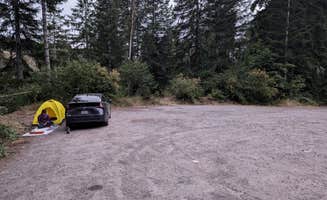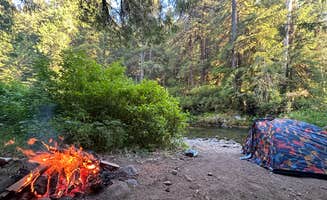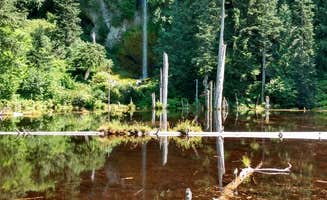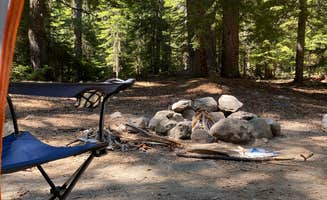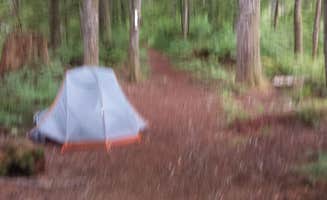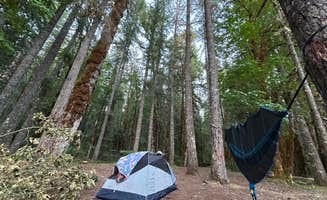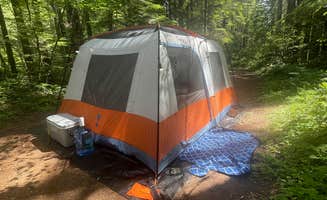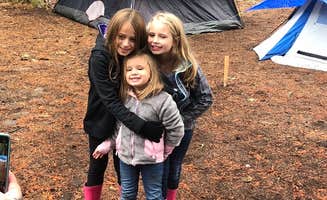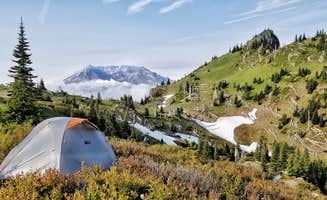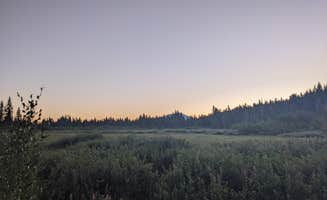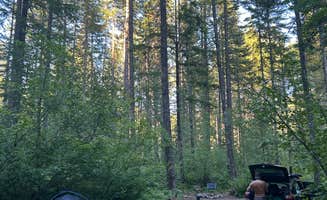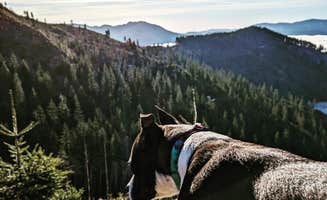Dispersed camping options near Woodland, Washington extend throughout the Gifford Pinchot National Forest at elevations ranging from 1,200 to 4,500 feet. The region features volcanic soil and steep terrain formed by Mount St. Helens' 1980 eruption. Summer temperatures typically range from 50-85°F with nighttime temperatures dropping significantly, even in August.
What to do
Hike to waterfalls: At Beaver Falls Trailhead, campers can access a short trail leading to a scenic waterfall. "The hike to the falls is to the far left of the pullout. Do NOT go down the super steep trails to the right. Beautiful waterfall after a short hike," notes Mike S. The trail is family-friendly and offers swimming opportunities during summer months.
Explore mushroom hunting: The forests around Butte Camp/Climbers Bivouac Dispersed Campsite provide excellent mushroom foraging during late summer and early fall. "During August and September, you can find tons of edible mushrooms," reports Starseed P. The area's diverse ecosystem supports multiple edible mushroom species in the volcanic soil.
Stargazing: The remote location of many sites offers excellent night sky viewing with minimal light pollution. At Tillamook State Forest Dispersed Camping, one camper mentioned, "Sunrise was one of best I've ever seen, especially with the clouds below." Clear nights provide opportunities to see the Milky Way and occasional meteor showers.
What campers like
Solitude and privacy: Many dispersed sites offer significant distance between camping spots. At Little Soda Springs Rd Dispersed, Lindsey N. found that "This location has 2-3 free sites you can drive in and, 2 more walk-in sites near the bridge." The area's layout allows campers to feel secluded even when other sites are occupied.
Creek access: Several campsites provide direct water access for cooling off during hot summer days. Vanessa T. reported about Little Soda Springs Rd: "It's a short hike down to the creek" from the first campsite. These water features provide natural cooling and ambiance without the crowds found at developed campgrounds.
Forest Service presence: Mount St. Helens Dispersed Camping and surrounding areas benefit from regular Forest Service patrols, providing added security while maintaining the wild character. "Forest Service rangers patrol these areas regularly to check permits and enforce regulations," ensuring rules are followed and reducing inappropriate use of these free camping areas near Woodland, Washington.
What you should know
Road conditions vary significantly: While some forest roads are partially paved, many deteriorate quickly, especially after winter. At Gifford Pinchot National Forest-Canyon Creek Dispersed Camping, Vanessa T. warned: "The coordinates here were incorrect coming from Hood River Oregon. It sent me down a rough dead end forest service road. I ended up lost on the mountain for 3 hours." Always research current road conditions before departing.
Navigation challenges: Cell service is virtually non-existent throughout the region. Chris J. noted about Canyon Creek: "No service. Like others said road getting in sucks." Download offline maps before arriving and bring physical maps as backup for no-cost camping locations.
Seasonal considerations: Spring conditions often include muddy access roads and potential flooding at creek-side sites. Summer brings increased fire restrictions and higher visitor numbers, especially on weekends. At Tillamook State Forest, one camper mentioned, "Heard some OHV noise at night, and target shooting in the distance at sunrise."
Tips for camping with families
Look for sites with natural features: Several free camping areas include creeks or small waterfalls that provide natural entertainment for children. At McBride Lake NF-81 Dispersed, Kevin W. found that "If you're going tent camping, there are about four flat places for tents. The area has no trails, so you would not have to worry about people wandering into the campsite."
Check accessibility: Some sites require minimal hiking to reach, making them better options for families with young children. Jeffrey P. observed at Little Soda Springs Rd that "There was an 'official' camp sight more near the Dry Creek Trail (has a bathroom)," offering an important amenity for families.
Safety considerations: Be aware of potential hazards like steep trails and wildlife. At Beaver Falls, ryan D. mentioned, "Cops came around about 930pm to inform me there is a high level of criminal activity around. To stay at my own risk." Always prioritize campsite safety when camping with children in remote areas.
Tips from RVers
Size restrictions: Most dispersed sites accommodate smaller RVs and trailers only. Kevin W. notes about Butte Camp: "Group camping with 4-5 places for tents and 2 maybe 3 spots for travel trailers but will need to back in. Solar friendly and level."
Leveling challenges: The volcanic terrain creates uneven surfaces at many sites. Bring leveling blocks and scout locations before committing to a spot. At Canyon Creek, Chris J. found that "Site I picked had a trail down to the creek that was nice."
Turnaround space: Limited turnaround areas make smaller rigs preferable. Kevin W. observed at McBride Lake that "Due to the narrow road, it may be a bit more snug with bigger rigs (25+ feet long and anything more than 8+ feet wide)," highlighting the importance of vehicle size considerations when seeking no-fee camping options near Woodland.


